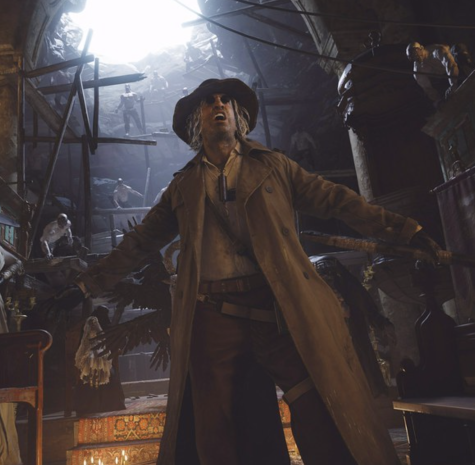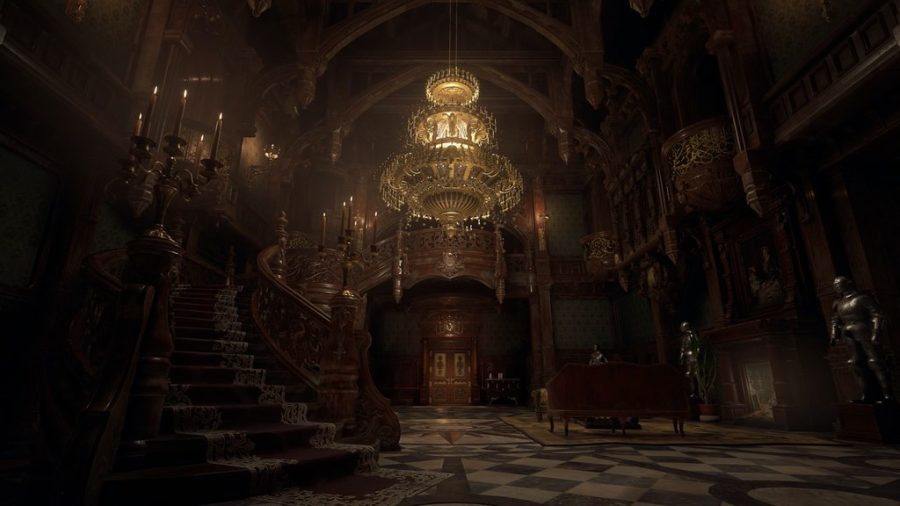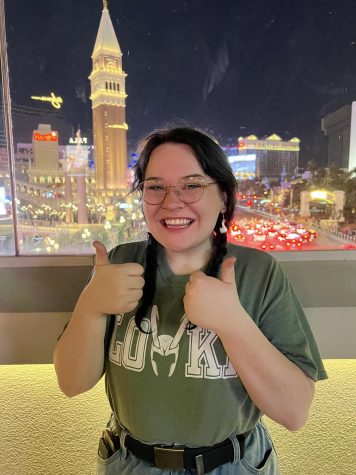Self-acceptance and growing through trauma: “Resident Evil 8 Village” DLC Review
Laken Kincaid writes about the newest addition to the Resident Evil franchise, the DLC for “Village.”
Nov 11, 2022
*WARNING: THIS ARTICLE CONTAINS SPOILERS FOR RESIDENT EVIL VILLAGE*
I never would have considered that the “Resident Evil” video game franchise would be one of my staple beats in journalism; the franchise is so niche outside of the world of gaming that I did not see a clear way to apply it to writing. Yet, my passion and love for this series seems to trump any kind of societal barriers this brand has because, despite the lack of an appeal to a mass audience, I feel like I could write about this journey for eons.
Luckily, instead of publishing dozens of pieces on my praise for “Resident Evil Village” or discussing the very minimal critiques I have of the story, recurring fans of this saga were blessed with new downloadable content (DLC) in a rerelease of the classic game on Oct. 28. While the rerelease does contain other new facets like a third person version of the original game and more options in the arena portion of the game, I was mostly excited for the new narrative included within the Winters’ Expansion: Rose’s story.
For those who have not read my long-winded rants about this game and do not know the plot of “Resident Evil Village,” I suggest you look at the original game (or my original articles) before diving into this review. However, for those who would not like to fall into a beautiful rabbit hole of suspenseful gameplay, I will provide a quick and bare-boned synopsis.
In the original game, distressed father Ethan Winters’ loses his daughter, Rosemary Winters, to a crazed scientist who uses a supernatural mold to try and bring back her own lost daughter, Eva. The mold, or mutamycete, gives those infected powers beyond the normal scope of reality. For example, as Ethan fights tooth and nail for Rose, he conquers a nine and a half foot tall vampire (along with her blood thirsty daughters made of flies), a clinically insane toy maker who can make her enemies suffer from hallucinations, a mutated fish monster and a sadistic factory worker who can bend metal to his will. In the end, Ethan must kill Miranda to save Rose and protect his wife Mia (who he previously thought was slain by special agents). After a hefty battle, Ethan dies but saves Rose and Mia, leaving the village in ruin.
Before Ethan’s death, there is a critical plot point that I think will impact the rest of the “Resident Evil” series. In a postmortem vision, Ethan speaks to “Resident Evil 7: Biohazard” antagonist, Eveline, who tells him that he has been dead for years and is only an amalgamation of the mold he continues to try and conquer. While this may have been a throwaway line as an attempt to canonically justify Ethan’s quick healing abilities, this interaction hugely alters how one sees not only the original game (and RE7 for that matter) but also the DLC.
Nevertheless, Ethan expires and, as “Resident Evil Village” concludes, the viewer gets one final cutscene where a grown Rose mourns her father until she is taken away by the government, presumably to be used as a weapon. The final text of the game that always gives me chills reads: “the father’s story is now done.”
The DLC picks up a little before this last scene. Angsty teen Rose is offered an opportunity to get rid of the powers she possesses from her relation to the mold from RE8 (remember, Ethan found out he was made of mold ever since 2017 meaning Rose is the same way) after years of bullying and probing from scientists. To destroy these abilities, Rose is instructed to enter the consciousness of the mold to find a purifying crystal. K, a new character who initially seems like a friend to Rose, says that the mutamycete keeps all of the memories of those who died near it, meaning she could reenter the village and find the remedy to her powers.
For the rest of the DLC, Rose navigates Castle Dimitrescu, House Beneviento and the village as a whole searching endlessly for a purifying crystal. She is accompanied on this path by a mysterious gold dust that is later revealed to be the memory of her father that the mold absorbed upon his death.
While it is impossible to get into every nitty gritty detail of the game (Arts & Life editor Claire Schuppel would never let me write again), it is important to note that the fan-favorite persona, the Duke, was the main antagonist for the first portion of the game inside the castle where we see distorted versions of other Rosemary Winters and dementor-like monsters that left me in a cold sweat. However, despite this cool call back, this section felt like filler space and it was my least favorite sector of the game. Frankly, I do not see how it contributes to the overall plot.
Yet, my opinion is drastically different for the rest of my playthrough. In House Beneviento, Rose fights killer dolls (much like the original game) and a mannequin of her own mother. Without delving too much into video game jargon, the mechanics of this section mimicked that of the Weeping Angels in “Doctor Who;” it was flat-out terrifying in the best way possible. But, I still think the most impactful portion of this section lies in the nuances behind the baby doll puzzles. This portion of the game beautifully serves as a commentary on Rose’s childhood trauma.

From seeing her original orange monkey toy from her crib to watching dolls mock her for the mold that makes up her anatomy, Rose is almost forced to regress to a child-like state to get through this portion of the game. Her size is even shrunk by three-fourths and she is pummeled with insults about her lack of friends or how “weird” she is. Unlike Ethan who, in the original game, had delusions of his wife and daughter, Rose continues to have visions of herself both as she normally presents and more distorted. This perfectly illustrates the rivaling fears between this father-daughter duo; Ethan’s biggest fear was losing his family while Rose’s biggest fear is losing herself.
Before Rose leaves House Beneviento, she is forced to battle Eveline. Eveline throws a monster temper tantrum and constantly blames Rose for being the death of her chance at happiness. In this instance, Eveline is the embodiment of the immaturity that could overtake Rose if she lets her insecurities consume her. If Rose would have harbored that anger she felt from growing up without a father figure and with strange abilities she never asked for, she would just be a mirror of this child who cannot grow old no matter how hard she tries. At the end of this sequence, she is saved by her father (whose face we finally get to see after years of anonymity).
In the end, right as Rose relinquishes her powers, Miranda emerges to claim her as a vessel for her long-lost daughter. While Ethan tries to fight Miranda, he is eventually pushed to his limits. Without any other option, Rose takes back her powers with some additional support from Ethan, killing the antagonist for (hopefully) the last time in the franchise. Rose is given a final moment with her father and the game ends with the same scene that “Resident Evil Village” did, showing that the story has come full circle.
Overall, I thoroughly enjoyed this DLC; it even left me with a few tears. I think it closed Ethan’s story, potentially opening the door for Rose to continue. There is an overarching theme of learning about and accepting oneself while still emphasizing the importance of having a support system to work through your personal issues. Ethan gave everything in this DLC to protect Rose and she (in her own mind) gave everything back by keeping the powers that caused her so much pain. While it’s only a short three hours, this story serves as a great bookend to remind the audience about the importance of family and relying on others for help when needed.
On a technical level, I have very few critiques. I adored the power mechanics Rose had with the mold and was taken aback by the stalker-ish, behind-the-back charges from the Mia mannequin I previously mentioned. The graphics were also very well done, especially for horror; I had visceral reactions each time I took damage. On the other hand, some of the dialogue felt forced and did not line up with the animation. A few spots in the game (like Eveline’s character model) were also a little unpolished. However, I did not see any major glitches or pitfalls at all.
The only things I would change about the DLC story-wise is that I would have lived to revisit both Moreau’s reservoir and Heisenberg’s factory, but I know we do not have all the time in the world and I am probably just stating this as an eternal Karl Heisenberg fan. I also wish the Castle Dimitrescu section would have been used more wisely. While it was fun to have the Duke as a ploy antagonist, hiding Miranda in the shadows, it felt like this portion of the story fell short compared to the other sections of the game.
All in all, this twisted tale continues to both terrify me and pull on my heartstrings. I do not know if the next game in this saga will be from Rose’s perspective or an all-new protagonist. However, if this DLC is an indicator of where the saga is going, I cannot wait to report back my findings in the future.














Hashir Bin Waseem • Jul 3, 2024 at 12:34 am
Resident Evil Village offers thrilling scares and a richly detailed world that kept me engaged throughout. Beyond the allure of Lady Dimitrescu, the game’s variety of monsters and well-paced gameplay stood out. The immersive sound design, especially with PS5’s 3D Audio, heightened the suspense. During my playthrough, Chris Redfield’s jacket caught my eye with its rugged style. Intrigued, I discovered a similar one—the Hound Wolf Squad Black Jacket—which quickly became my favorite. Its blend of comfort and durability makes it perfect for any adventure. You can check it out here at safyd store. A 10% off on whole store is ended some days ago. maybe again it will come, but its price is already very reasonable.